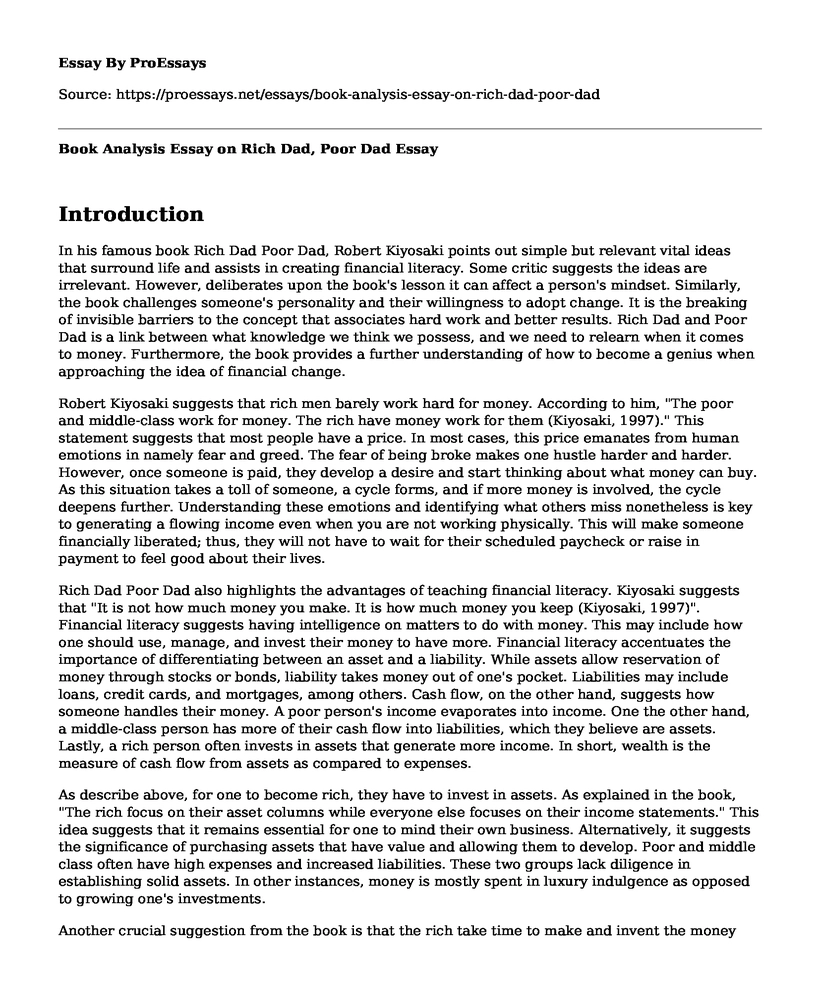Introduction
In his famous book Rich Dad Poor Dad, Robert Kiyosaki points out simple but relevant vital ideas that surround life and assists in creating financial literacy. Some critic suggests the ideas are irrelevant. However, deliberates upon the book's lesson it can affect a person's mindset. Similarly, the book challenges someone's personality and their willingness to adopt change. It is the breaking of invisible barriers to the concept that associates hard work and better results. Rich Dad and Poor Dad is a link between what knowledge we think we possess, and we need to relearn when it comes to money. Furthermore, the book provides a further understanding of how to become a genius when approaching the idea of financial change.
Robert Kiyosaki suggests that rich men barely work hard for money. According to him, "The poor and middle-class work for money. The rich have money work for them (Kiyosaki, 1997)." This statement suggests that most people have a price. In most cases, this price emanates from human emotions in namely fear and greed. The fear of being broke makes one hustle harder and harder. However, once someone is paid, they develop a desire and start thinking about what money can buy. As this situation takes a toll of someone, a cycle forms, and if more money is involved, the cycle deepens further. Understanding these emotions and identifying what others miss nonetheless is key to generating a flowing income even when you are not working physically. This will make someone financially liberated; thus, they will not have to wait for their scheduled paycheck or raise in payment to feel good about their lives.
Rich Dad Poor Dad also highlights the advantages of teaching financial literacy. Kiyosaki suggests that "It is not how much money you make. It is how much money you keep (Kiyosaki, 1997)". Financial literacy suggests having intelligence on matters to do with money. This may include how one should use, manage, and invest their money to have more. Financial literacy accentuates the importance of differentiating between an asset and a liability. While assets allow reservation of money through stocks or bonds, liability takes money out of one's pocket. Liabilities may include loans, credit cards, and mortgages, among others. Cash flow, on the other hand, suggests how someone handles their money. A poor person's income evaporates into income. One the other hand, a middle-class person has more of their cash flow into liabilities, which they believe are assets. Lastly, a rich person often invests in assets that generate more income. In short, wealth is the measure of cash flow from assets as compared to expenses.
As describe above, for one to become rich, they have to invest in assets. As explained in the book, "The rich focus on their asset columns while everyone else focuses on their income statements." This idea suggests that it remains essential for one to mind their own business. Alternatively, it suggests the significance of purchasing assets that have value and allowing them to develop. Poor and middle class often have high expenses and increased liabilities. These two groups lack diligence in establishing solid assets. In other instances, money is mostly spent in luxury indulgence as opposed to growing one's investments.
Another crucial suggestion from the book is that the rich take time to make and invent the money they have. Kiyosaki suggests that those who get ahead in real life are those who are bold and not necessarily smart (Kiyosaki, 1997). Perhaps this suggests that possessing financial freedom requires both financial intelligence and guts. It may also imply that calculating risks remains a viable way to reap numerous benefits. While saving is crucial, it does not reap as much wealth and benefits compared to investing. The rich invest their money by finding opportunities missed by other people. Additionally, managing risks remains crucial in that you do not avoid risks too much in the hope of evading losses, and in the end, miss opportunities.
A good number of individuals work to earn. However, this should not be the case. Financially stable individuals see a job opportunity as a learning process (Kiyosaki, 1997). As Kiyosaki suggests, his educated dad held so much on job security (Kiyosaki, 1997). On the other hand, his rich dad found meaning in learning. This is relevant in daily activities as jobs enable one to develop skills that translate later to making them successful. When someone takes a job opportunity as a learning platform, then it would be easy to transfer the acquired skills to any existing earning opportunity.
Chapters from Rich Dad Poor Dad gives the reader various ways to create and build their wealth. Kiyosaki's ideas revolving around financial freedom and literacy suggest ways in which rich people continue to possess wealth. At the same time, it critics the poor and middle class for their inconsiderable bad spending habits that continues to make them poor and average. As opposed to these other groups of people, rich individuals uphold knowledge as a vital tool in building their domains.
Reference
Kiyosaki, R. T. (1997). Rich Dad, Poor Dad. US: Tech Press, Inc
Cite this page
Book Analysis Essay on Rich Dad, Poor Dad. (2023, May 18). Retrieved from https://proessays.net/essays/book-analysis-essay-on-rich-dad-poor-dad
If you are the original author of this essay and no longer wish to have it published on the ProEssays website, please click below to request its removal:
- Personal Essay Example: Identity and Socialization
- Killings by Andre Dubus Essay Example
- The Portrayal of Love in Romeo and Juliette - Literary Analysis Essay
- Essay Sample on Girl by Jamaica Kincaid And All the World's A Stage
- The Marrow Thieves: A Dystopian Future of Dreams Lost
- Poetry Analysis Essay on My Doggy Ate My Homework: A Tale of Amazing Dogs
- Essay Example on Analyzing Poetry: Examining Assumptions and Evidence







